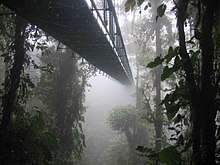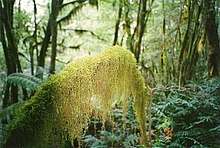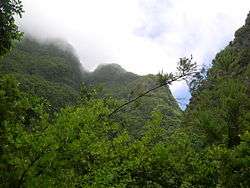Cloud forest
A cloud forest, also called a water forest, primas forest, or tropical montane cloud forest (TMCF), is a generally tropical or subtropical, evergreen, montane, moist forest characterized by a persistent, frequent or seasonal low-level cloud cover, usually at the canopy level, formally described in the International Cloud Atlas (2017) as silvagenitus.[1][2] Cloud forests often exhibit an abundance of mosses covering the ground and vegetation, in which case they are also referred to as mossy forests. Mossy forests usually develop on the saddles of mountains, where moisture introduced by settling clouds is more effectively retained.[3]

Other moss forests include Black Spruce/Feathermoss climax forest, with a moderately dense canopy and a forest floor of feathermosses including Hylocomium splendens, Pleurozium schreberi and Ptilium crista-castrensis.[4] These weft-form mosses grow in boreal moss forests,[5] and are shaped to allow the needles to fall into them rather than covering them, so they grow over the needles.[6]
Distribution and climate

The presence of cloud forests is dependent on local climate (which is affected by the distance to the sea), the exposition and the latitude (from 23°N to 25°S), and the elevation (which varies from 500 m to 4000 m above sea level). Typically, there is a relatively small band of elevation in which the atmospheric environment is suitable for cloud forest development. This is characterized by persistent fog at the vegetation level, resulting in the reduction of direct sunlight and thus of evapotranspiration.[7][8] Within cloud forests, much of the moisture available to plants arrives in the form of fog drip, where fog condenses on tree leaves and then drips onto the ground below.
Annual rainfall can range from 500 to 10,000 mm/year and mean temperature between 8 and 20 °C.[7][8]
While cloud forest today is the most widely used term, in some regions, these ecosystems or special types of cloud forests are called mossy forest, elfin forest, montane thicket, and dwarf cloud forest.[8]
The definition of cloud forest can be ambiguous, with many countries not using the term (preferring such terms as Afromontane forest and upper montane rain forest, montane laurel forest, or more localised terms such as the Bolivian yungas, and the laurisilva of the Atlantic Islands),[9][10] and occasionally subtropical and even temperate forests in which similar meteorological conditions occur are considered to be cloud forests.
Only 1% of the global woodland consists of cloud forests.[7] They previously comprised an estimated 11% of all tropical forests in the 1970s. A total of around 736 cloud forest sites have been identified in 59 countries by the World Conservation Monitoring Centre, with 327 of them legally protected areas as of 2002. Important areas of cloud forest are in Central and South America (mainly Venezuela, Honduras, Mexico, Ecuador, and Colombia), East and Central Africa, India, Sri Lanka, Thailand, Indonesia, Malaysia, the Philippines, Hawaii, Papua New Guinea, and in the Caribbean.[1][11]
Characteristics

In comparison with lower tropical moist forests, cloud forests show a reduced tree stature combined with increased stem density and generally the lower diversity of woody plants.[7][8] Trees in these regions are generally shorter and more heavily stemmed than in lower-altitude forests in the same regions, often with gnarled trunks and branches, forming dense, compact crowns. Their leaves become smaller, thicker and harder with increasing altitude.[12] The high moisture promotes the development of a high biomass and biodiversity of epiphyte, particularly bryophytes, lichens, ferns (including filmy ferns), bromeliads and orchids.[7][8] The number of endemic plants can be very high.[7]
An important feature of cloud forests is the tree crowns can intercept the wind-driven cloud moisture, part of which drips to the ground. This fog drip occurs when water droplets from the fog adhere to the needles or leaves of trees or other objects, coalesce into larger drops and then drop to the ground.[13] It can be an important contribution to the hydrologic cycle.[8]
Due to the high water content of the soil, the reduced solar radiation and the low rates of decomposition and mineralization, the soil acidity is very high,[8][14][15] with more humus and peat often forming the upper soil layer.[8]
Stadtmüller (1987) distinguishes two general types of tropical montane cloud forests:
- Areas with a high annual precipitation due to a frequent cloud cover in combination with heavy and sometimes persistent orographic rainfall; such forests have a perceptible canopy strata, a high number of epiphytes, and a thick peat layer which has a high storage capacity for water and controls the runoff;
- In drier areas with mainly seasonal rainfall, cloud stripping can amount to a large proportion of the moisture available to plants.
Temperate cloud forests
Although far from being universally accepted as true cloud forests, several forests in temperate regions have strong similarities with tropical cloud forests. The term is further confused by occasional reference to cloud forests in tropical countries as "temperate" due to the cooler climate associated with these misty forests.

Distribution of temperate cloud forests
- Argentina – Salta, Jujuy, Catamarca and Tucumán (Southern Andean Yungas)
- Australia – Lamington National Park, Springbrook National Park, Mount Bartle Frere and Mount Bellenden Ker (Queensland) and Mount Gower (Lord Howe Island)
- Brazil – Serra do Mar coastal forests
- Canada – Coastal British Columbia
- Chile – Bosque de Fray Jorge National Park
- Costa Rica - Monteverde Cloud Forest Reserve, Braulio Carrillo National Park, and Juan Castro Blanco National Park
- People's Republic of China – Yunnan Plateau, mountains of southern and eastern China
- Republic of China (Taiwan) – Yuanyang Lake Nature Reserve, Chatianshan Nature Reserve, and Fuxing District in Taoyuan
- Iran – Eastern part of Alborz mountains, north of Iran, Golestan Province
- Japan – parts of Yakushima Island
- New Zealand – parts of Fiordland, Mount Taranaki and Mount Cargill, near Dunedin
- Pakistan – Shoghran Forest in the Kaghan Valley, and regions of Upper Swat in the north west of Pakistan
- Peru – Peruvian Cloud Forest
- Portugal – Azores and Madeira (laurisilva)
- Spain – Canary Islands (laurisilva) and very locally in Cádiz province.
- United States – Hawaii, Cloud Forests United, Kona Cloud Forest Sanctuary, and Kailua-Kona
Importance

- Watershed function: Because of the cloud-stripping strategy, the effective rainfall can be doubled in dry seasons and increase the wet season rainfall by about 10%.[16][10][17] Experiments of Costin and Wimbush (1961) showed that the tree canopies of non-cloud forests intercept and evaporate 20 percent more of the precipitation than cloud forests, which means a loss to the land component of the hydrological cycle.
- Vegetation: Tropical montane cloud forests are not as species-rich as tropical lowland forests, but they provide the habitats for many species found nowhere else.[18][10] For example, the Cerro de la Neblina, a cloud-covered mountain in the south of Venezuela, accommodates many shrubs, orchids, and insectivorous plants which are restricted to this mountain only.[18]
- Fauna: The endemism in animals is also very high. In Peru, more than one-third of the 270 endemic birds, mammals, and frogs are found in cloud forests.[18] One of the best-known cloud forest mammals is the Spectacled Bear (Tremarctos ornatus).Many of those endemic animals have important functions, such as seed dispersal and forest dynamics in these ecosystems.[8]
Current situation

In 1970, the original extent of cloud forests on the Earth was around 50 million hectares. Population growth, poverty and uncontrolled land use have contributed to the loss of cloud forests. The 1990 Global Forest Survey found that 1.1% of tropical mountain and highland forests were lost each year, which was higher than in any other tropical forests.[18] In Colombia, one of the countries with the largest area of cloud forests, only 10–20% of the initial cloud forest cover remains.[7] Significant areas have been converted to plantations, or for use in agriculture and pasture. Significant crops in montane forest zones include tea and coffee, and the logging of unique species causes changes to the forest structure.[8]
In 2004, an estimated one-third of all cloud forests on the planet were protected at that time.[19]
Impact of climate change
Because of their delicate dependency on local climates, cloud forests will be strongly affected by global climate change. Results show that the extent of environmentally suitable areas for cloud forest in Mexico will sharply decline in the next 70 years.[20] A number of climate models suggest low-altitude cloudiness will be reduced, which means the optimum climate for many cloud forest habitats will increase in altitude.[21][22] Linked to the reduction of cloud moisture immersion and increasing temperature, the hydrological cycle will change, so the system will dry out.[22] This would lead to the wilting and the death of epiphytes, which rely on high humidity.[21] Frogs and lizards are expected to suffer from increased drought.[22] Calculations suggest the loss of cloud forest in Mexico would lead to extinction of up to 37 vertebrates specific to that region.[23] In addition, climate changes can result in a higher number of hurricanes, which may increase damage to tropical montane cloud forests. All in all, the results of climate change will be a loss in biodiversity, altitude shifts in species ranges and community reshuffling, and, in some areas, complete loss of cloud forests.[21]
In botanical gardens
Cloud-forest conditions are hard and expensive to replicate in a glasshouse because it is necessary to maintain a very high humidity. This is usually expensive as a high temperature must usually be maintained as well, and a high temperature combined with high humidity calls for good air circulation or else fungi and algae will develop. Such displays usually are quite small, but there are some notable exceptions. For many years, the Singapore Botanic Gardens had a so-called coolhouse. The Gardens by the Bay features a 0.8 hectares (2.0 acres) coolhouse that is simply named "Cloud Forest". The latter features a 35-metre (115 ft)-high artificial mountain clad in epiphytes such as orchids, ferns, clubmosses, bromeliads and others.[24] Due to a relatively mild climate and summer fog, the San Francisco Botanical Garden has three outdoor cloud forest collections, including a 2-acre Mesoamerican Cloud Forest established in 1985.[25] The Buffalo and Erie County Botanical Gardens contains a "Panama Cloud Forest" garden in House 11.[26]
Footnotes
- Hostettler, Silvia (2002). "Tropical Montane Cloud Forests: A Challenge for Conservation". Bois et Forets des Tropiques. 274 (4): 19–31.
- Sutherland, Scott (March 23, 2017). "Cloud Atlas leaps into 21st century with 12 new cloud types". The Weather Network. Pelmorex Media. Retrieved 24 March 2017.
- Clarke 1997, p. 29.
- C. Michael Hogan, 2008. Black Spruce: Picea mariana, GlobalTwitcher.com, ed. Nicklas Stromberg
- Poller, Sonya (22 January 2015). "Alberta's Wonderful World of Bryophytes". Alberta Biodiversity Monitoring Institute Blog. Alberta Biodiversity Monitoring Institute.
- Cullina, William. "Gardening With Moss". Horticulture.
- Häger 2006, p. .
- Hamilton, Juvik & Scatena 1995.
- García-Santos, Bruijnzeel & Dolman 2009.
- García-Santos 2007, p. .
- "Resources Data - UNEP-WCMC". unep-wcmc.org.
- Bruijnzeel & Proctor 1995 quote from Hamilton, Juvik & Scatena 1995
- "Fog drip - AMS Glossary". American Meteorological Society. Retrieved 2014-12-15.
- van Steenis 1972, p. .
- Grubb & Tanner 1976.
- Vogelmann 1973 and Bruijnzeel 1990, p. quote by Hamilton, Juvik & Scatena 1995
- Köhler, Lars; Tobón, Conrado; Frumau, K. F. Arnoud; Bruijnzeel, L. A. (Sampurno) (2007-12-01). "Biomass and water storage dynamics of epiphytes in old-growth and secondary montane cloud forest stands in Costa Rica". Plant Ecology. 193 (2): 171–184. doi:10.1007/s11258-006-9256-7. ISSN 1573-5052.
- Bruijnzeel & Hamilton 2000, p. .
- Kappelle 2004 quote by Häger 2006, p.
- Ponce-Reyes et al. 2013.
- Foster 2001.
- Bubb et al. 2004, p. .
- Ponce-Reyes et al. 2012.
- "Cloud Forest Facts and Figures".
- "SFBG Plant Collections".
- "Our Gardens". Buffalo Botanical Gardens. 2020.
References
- Bruijnzeel, L. A. (1990). Hydrology of Moist Tropical Forests and Effects of Conversion: A State of Knowledge Review. OCLC 222853422.CS1 maint: ref=harv (link)
- Bruijnzeel, L.A.; Hamilton, L.S. (2000). Decision Time For Cloud Forests: Water-Related Issues And Problems Of The Humid Tropics And Other Warm Humid Regions. Paris, France: UNESCO's IHP Humid Tropics Programme Series No.13.CS1 maint: ref=harv (link)
- Bruijnzeel, L. A; Proctor, J (1995). "Hydrology and Biogeochemistry of Tropical Montane Cloud Forests: What Do We Really Know?". In Hamilton, Lawrence S.; Juvik, James O.; Scatena, F. N. (eds.). Tropical Montane Cloud Forests. Ecological Studies. 110. pp. 38–78. doi:10.1007/978-1-4612-2500-3_3. ISBN 978-1-4612-7564-0.CS1 maint: ref=harv (link)
- Bubb, Philip; May, Ian; Miles, Lera; Sayer, Jeff (2004). Cloud Forest Agenda. ISBN 92-807-2399-5. Archived from the original on 2017-12-26. Retrieved 2017-12-26.CS1 maint: ref=harv (link)
- Foster, Pru (2001). "The potential negative impacts of global climate change on tropical montane cloud forests". Earth-Science Reviews. 55 (1–2): 73–106. Bibcode:2001ESRv...55...73F. doi:10.1016/S0012-8252(01)00056-3.CS1 maint: ref=harv (link)
- Clarke, Charles (1997). Nepenthes of Borneo. ISBN 978-983-812-015-9.CS1 maint: ref=harv (link)
- García-Santos, G; Marzol, M. V; Aschan, G (2004). "Water dynamics in a laurel montane cloud forest in the Garajonay National Park (Canary Islands, Spain)". Hydrology and Earth System Sciences. 8 (6): 1065–75. Bibcode:2004HESS....8.1065G. doi:10.5194/hess-8-1065-2004.CS1 maint: ref=harv (link)
- García-Santos, G. (2007). An ecohydrological and soils study in a montane cloud forest in the National Park of Garajonay, La Gomera (Canary Islands, Spain) (PhD Thesis). hdl:1871/12697.CS1 maint: ref=harv (link)
- García-Santos, G; Bruijnzeel, L.A; Dolman, A.J (2009). "Modelling canopy conductance under wet and dry conditions in a subtropical cloud forest". Agricultural and Forest Meteorology. 149 (10): 1565–72. Bibcode:2009AgFM..149.1565G. doi:10.1016/j.agrformet.2009.03.008.CS1 maint: ref=harv (link)
- Grubb, PJ; Tanner, EVJ (July 1976). "The montane forests and soils of Jamaica: a reassessment". Journal of the Arnold Arboretum. 57 (3): 313–68. JSTOR 43794514.CS1 maint: ref=harv (link)
- Häger, Achim (2006). Einfluss von Klima und Topographie auf Struktur, Zusammensetzung und Dynamik eines tropischen Wolkenwaldes in Monteverde, Costa Rica [Influence of climate and topography on the structure, composition and dynamics of a tropical cloud forest in Monteverde, Costa Rica] (Disssertation) (in German). hdl:11858/00-1735-0000-0006-B0EE-1.CS1 maint: ref=harv (link)
- Hamilton, Lawrence S; Juvik, James O; Scatena, F. N (1995). "The Puerto Rico Tropical Cloud Forest Symposium: Introduction and Workshop Synthesis". In Hamilton, Lawrence S.; Juvik, James O.; Scatena, F. N. (eds.). Tropical Montane Cloud Forests. Ecological Studies. 110. pp. 1–18. doi:10.1007/978-1-4612-2500-3_1. ISBN 978-1-4612-7564-0.CS1 maint: ref=harv (link)
- Kappelle, M (2004). "Tropical Montane Forests". In Burley, Jeffery (ed.). Encyclopedia of Forest Sciences. pp. 1782–92. doi:10.1016/B0-12-145160-7/00175-7. ISBN 978-0-12-145160-8.CS1 maint: ref=harv (link)
- Ponce-Reyes, Rocío; Reynoso-Rosales, Víctor-Hugo; Watson, James E. M; Vanderwal, Jeremy; Fuller, Richard A; Pressey, Robert L; Possingham, Hugh P (2012). "Vulnerability of cloud forest reserves in Mexico to climate change" (PDF). Nature Climate Change. 2 (6): 448–52. Bibcode:2012NatCC...2..448P. doi:10.1038/nclimate1453.CS1 maint: ref=harv (link)
- Ponce-Reyes, Rocio; Nicholson, Emily; Baxter, Peter W. J; Fuller, Richard A; Possingham, Hugh (2013). "Extinction risk in cloud forest fragments under climate change and habitat loss". Diversity and Distributions. 19 (5–6): 518–29. doi:10.1111/ddi.12064.CS1 maint: ref=harv (link)
- van Steenis, Cornelis Gijsbert Gerrit Jan (1972). The Mountain Flora of Java. Brill. OCLC 741884105.CS1 maint: ref=harv (link)
- Vogelmann, H. W (1973). "Fog Precipitation in the Cloud Forests of Eastern Mexico". BioScience. 23 (2): 96–100. doi:10.2307/1296569. JSTOR 1296569.CS1 maint: ref=harv (link)
External links
| Wikimedia Commons has media related to Cloud forests. |
- Monteverde Costa Rica Cloud Forest
- Tropical Montane Cloud Forest Initiative
- Monteverde Cloud Forest Ecology
- Roach, John (August 13, 2001). "Cloud Forests Fading in the Mist, Their Treasures Little Known". National Geographic News
- An Ecological Reserve in the Cloud Forest of Mindo Ecuador
- Cloud Forests United
- Kona Cloud Forest Guided Walking Tours - Kelly Dunn
Tropical hydrology and cloud forests project
- Hydrology of tropical cloud forests project
- Cloud Forest Video - Rara Avis CR
- Tropical Montane Cloud Forests – Science for Conservation and Management (L.A. Bruijnzeel, F.N. Scatena and L.S. Hamilton, 2011)
- Andes Biodiversity and Ecosystem Research Group
- Costin, A.B.; Wimbush, D.J. (1961). Studies in catchment hydrology in the Australian Alps. IV, Interception by trees of rain, cloud, and fog. OCLC 822214607.
- Stadtmüller, Thomas (1987). Cloud Forests in the Humid Tropics: A Bibliographic Review. ISBN 978-92-808-0670-0.